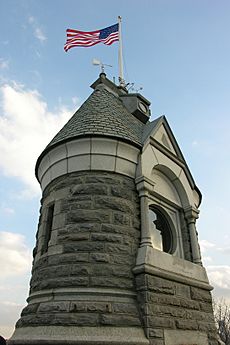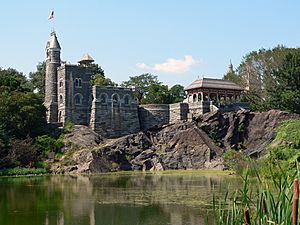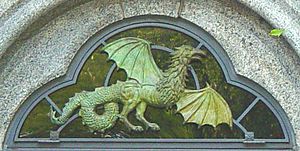Belvedere Castle facts for kids
Belvedere Castle is a special building in Central Park in Manhattan, New York City. It looks like a castle, but it's actually a "folly"—a building made just for decoration and to offer amazing views. Inside, you'll find exhibit rooms and a place to look out over the park. Since 1919, it has also been home to Central Park's official weather station.
The castle was designed by Frederick Law Olmsted and Calvert Vaux between 1867 and 1869. It mixes two old building styles: Gothic and Romanesque. Vaux designed it using local rock called Manhattan schist and granite. The name "Belvedere" comes from Italian and means "beautiful view."
Contents
What is Belvedere Castle?
A Unique Design and Purpose

Belvedere Castle was first built as an open shell with empty doorways and windows. Its main tower looked like a medieval castle. In 1983, the tower was updated to look more German. It now has a flag, a weather vane (to show wind direction), and an anemometer (to measure wind speed). These tools help record the official weather for Central Park.
Two fancy wooden shelters that were part of the original design wore out over time. They were removed before the year 1900.
Central Park's Weather Station
Since 1919, Belvedere Castle has hosted the New York Meteorological Observatory. This is where the United States Weather Bureau collected weather information. Today, the main weather station is just south of the castle. However, the wind-measuring equipment is still on the castle's main tower.
Location and Views
The castle sits on top of Vista Rock, a 130-foot-tall rock formation. This rock is the park's second-highest natural spot. The castle is built from rock found right in the park, along with gray granite. It overlooks the wild-looking woodlands of The Ramble. From the formal Bethesda Terrace, you can see the castle towering above.
Underneath the natural rock, a special road was built. This sunken road allows cars and trucks to pass through the park without disturbing its natural beauty.
Visitor Center and Programs
Today, Belvedere Castle is a busy visitor center and gift shop. Many free programs for families and the community happen here. You can learn about birds and other nature topics from the Central Park Conservancy. NYC Urban Park Rangers also lead programs about history and nature. These include stargazing, astronomy, and learning about wildlife.
The eastern side of the castle used to face a large water reservoir. This reservoir was filled in with building rubble starting in the 1930s. Now, the eastern side of the castle overlooks the Great Lawn and Turtle Pond. This large grassy area and pond sit where the old reservoir used to be.
History of Belvedere Castle
Early Plans and Construction
The castle was designed by architects Calvert Vaux and Jacob Wrey Mould. It was an extra feature for the Greensward Plan, which was the main design for Central Park. Vaux and Frederick Law Olmsted created this plan. In 1867, Vaux decided to build Belvedere Castle on top of Vista Rock. This spot offered great views of the Croton Reservoir. There was already a fire tower there, which was taken down.
The first plans for Belvedere Castle included two stone towers. One was larger on the east side, and a smaller one was planned for the west. However, to save money, the plans were changed in 1870. The castle was finished as an open wooden building. The eastern part was done by 1871, but the western part was never built. As trees grew taller, the castle became harder to see from its original planned viewpoints. Its tower is the highest point in Central Park.
Restoration and Reopening
In the 1960s, the New York Meteorological Observatory moved its offices. Belvedere Castle was then closed to the public. It became damaged by vandalism and neglect. The Central Park Conservancy started a big project to fix it up. On May 1, 1983, the castle reopened. The original tower was replaced, and the wooden shelters were rebuilt. The castle was turned into a visitor center.
In 1995, the Conservancy's team restored the castle's painted wooden porch, using Vaux's original designs. That same year, a grant of $340,000 helped restore the castle as the Henry Luce Nature Center. This work was finished in 1996.
In 2018, the Central Park Conservancy did another renovation of Belvedere Castle. They replaced old doors and windows with new, energy-efficient ones. They also built a new path to make it easier for everyone to visit, including people with disabilities. After this $12 million renovation, the castle reopened on June 28, 2019.
See also
 In Spanish: Castillo Belvedere para niños
In Spanish: Castillo Belvedere para niños



